Anna Academic Store
Quality Verified & up-to-date Academic Papers!!
- 1033
- 0
- 0
Community
- Followers
- Following
2 Reviews received
1033 items
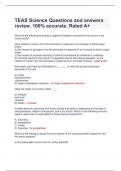
TEAS Science Questions and answers review. 100% accurate. Rated A+
Which of the following illustrates a negative feedback mechanism that occurs in the human body? a)the release of insulin from the pancreas in response to an increase in blood sugar levels b) the release of glucagon from the pancreas in response to an increase in blood- sugar levels c) the release of oxytocin resulting in uterine contractions as childbirth is underway d) chemical reactions that result in coagulation due to fibrin being released - a) the release of insulin from the pancrea...
- Exam (elaborations)
- • 36 pages •
Which of the following illustrates a negative feedback mechanism that occurs in the human body? a)the release of insulin from the pancreas in response to an increase in blood sugar levels b) the release of glucagon from the pancreas in response to an increase in blood- sugar levels c) the release of oxytocin resulting in uterine contractions as childbirth is underway d) chemical reactions that result in coagulation due to fibrin being released - a) the release of insulin from the pancrea...
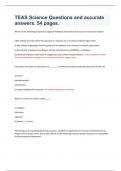
TEAS Science Questions and accurate answers. 54 pages.
Which of the following illustrates a negative feedback mechanism that occurs in the human body? a)the release of insulin from the pancreas in response to an increase in blood sugar levels b) the release of glucagon from the pancreas in response to an increase in blood- sugar levels c) the release of oxytocin resulting in uterine contractions as childbirth is underway d) chemical reactions that result in coagulation due to fibrin being released - a) the release of insulin from the pancreas i...
- Exam (elaborations)
- • 54 pages •
Which of the following illustrates a negative feedback mechanism that occurs in the human body? a)the release of insulin from the pancreas in response to an increase in blood sugar levels b) the release of glucagon from the pancreas in response to an increase in blood- sugar levels c) the release of oxytocin resulting in uterine contractions as childbirth is underway d) chemical reactions that result in coagulation due to fibrin being released - a) the release of insulin from the pancreas i...
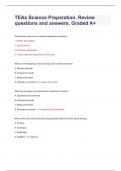
TEAs Science Preparation. Review questions and answers. Graded A+
The first four steps of the scientific method are as follows: I. Identify the problem II. Ask Questions III. Develop a hypothesis IV. Collect data and experiment on that data Which of the following is the next step in the scientific method? A. Observe the data B. Analyze the results C. Measure the data D. Develop a conclusion - B. Analyze the results What are two types of measurement important in science? A. Quantitive and numerical B. Analyze the results C. Measure the data D. Dev...
- Exam (elaborations)
- • 16 pages •
The first four steps of the scientific method are as follows: I. Identify the problem II. Ask Questions III. Develop a hypothesis IV. Collect data and experiment on that data Which of the following is the next step in the scientific method? A. Observe the data B. Analyze the results C. Measure the data D. Develop a conclusion - B. Analyze the results What are two types of measurement important in science? A. Quantitive and numerical B. Analyze the results C. Measure the data D. Dev...
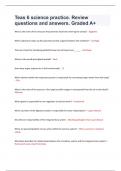
Teas 6 science practice. Review questions and answers. Graded A+
What is the name of the structure that prevents food from entering the airway? - Epiglottis Which substance makes up the pads that provide support between the vertebrae? - Cartilage The two criteria for classifying epithelial tissue are cell layers and ______ - Cell shape Where is the parathyroid gland located? - Neck How many organ systems are in the human body? - 11 Which element within the respiratory system is responsible for removing foreign matter from the lungs? - Cilia What is the...
- Exam (elaborations)
- • 8 pages •
What is the name of the structure that prevents food from entering the airway? - Epiglottis Which substance makes up the pads that provide support between the vertebrae? - Cartilage The two criteria for classifying epithelial tissue are cell layers and ______ - Cell shape Where is the parathyroid gland located? - Neck How many organ systems are in the human body? - 11 Which element within the respiratory system is responsible for removing foreign matter from the lungs? - Cilia What is the...
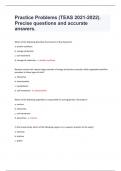
Practice Problems (TEAS 2021-2022). Precise questions and accurate answers.
Which of the following describes the function of the ribosome? a. protein synthesis b. energy production c. cell movement d. storage of molecules - a. protein synthesis Because muscle cells require large amounts of energy to function correctly, which organelles would be prevalent in those types of cells? a. ribosomes b. mitochondria c. cytoskeleton d. cell membrane - b. mitochondria Which of the following organelles is responsible for storing genetic information? a. nucleus b. ribos...
- Exam (elaborations)
- • 13 pages •
Which of the following describes the function of the ribosome? a. protein synthesis b. energy production c. cell movement d. storage of molecules - a. protein synthesis Because muscle cells require large amounts of energy to function correctly, which organelles would be prevalent in those types of cells? a. ribosomes b. mitochondria c. cytoskeleton d. cell membrane - b. mitochondria Which of the following organelles is responsible for storing genetic information? a. nucleus b. ribos...
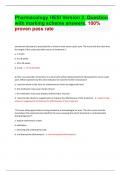
Pharmacology HESI Version 2. Question with marking scheme answers. 100% proven pass rate
Isotretinoin (Accutane) is prescribed for a client to treat severe cystic acne. The nurse tells the client that the length of the usual prescribed course of treatment is: a. 1 month b. 4 to 8 weeks c. 15 to 20 weeks d. 1 year - c. 15 to 20 weeks A clinic nurse provides instructions to a client who will be taking isotretinoin (Accutane) for severe cystic acne. Which statement by the client indicates the need for further instructions? a. I need to return to the clinic for a blood test to c...
- Exam (elaborations)
- • 6 pages •
Isotretinoin (Accutane) is prescribed for a client to treat severe cystic acne. The nurse tells the client that the length of the usual prescribed course of treatment is: a. 1 month b. 4 to 8 weeks c. 15 to 20 weeks d. 1 year - c. 15 to 20 weeks A clinic nurse provides instructions to a client who will be taking isotretinoin (Accutane) for severe cystic acne. Which statement by the client indicates the need for further instructions? a. I need to return to the clinic for a blood test to c...
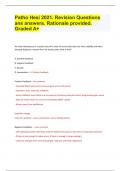
Patho Hesi 2021. Revision Questions ans answers. Rationale provided. Graded A+
An initial disturbance in a system sets off a chain of events that does not favor stability and often abruptly displaces a system from its steady state: what is that? A. positive feedback B. negative feedback C. disease D. homeostasis - A. Positive feedback Positive Feedback - -less common - Snowball Effect (some pain/ pressure gets worse and worse) - examples: clots, sneezing, childbirth - when childbirth starts there is an increase in hormone production which progressively gets worse ...
- Exam (elaborations)
- • 60 pages •
An initial disturbance in a system sets off a chain of events that does not favor stability and often abruptly displaces a system from its steady state: what is that? A. positive feedback B. negative feedback C. disease D. homeostasis - A. Positive feedback Positive Feedback - -less common - Snowball Effect (some pain/ pressure gets worse and worse) - examples: clots, sneezing, childbirth - when childbirth starts there is an increase in hormone production which progressively gets worse ...
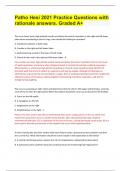
Patho Hesi 2021 Practice Questions with rationale answers. Graded A+
The nurse hears short, high-pitched sounds just before the end of inspiration in the right and left lower lobes when auscultating a client's lungs. How should this finding be recorded? A. Inspiratory wheezes in both lungs B. Crackles in the right and left lower lobes C. Abdominal lung sounds in the bases of both lungs D. Pleural friction rub in the right and left lower lobes - B Fine crackles are short, high pitched sounds heard just before the end of inspiration that are the result of r...
- Exam (elaborations)
- • 19 pages •
The nurse hears short, high-pitched sounds just before the end of inspiration in the right and left lower lobes when auscultating a client's lungs. How should this finding be recorded? A. Inspiratory wheezes in both lungs B. Crackles in the right and left lower lobes C. Abdominal lung sounds in the bases of both lungs D. Pleural friction rub in the right and left lower lobes - B Fine crackles are short, high pitched sounds heard just before the end of inspiration that are the result of r...
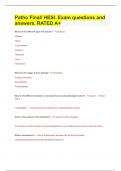
Patho Final/ HESI. Exam questions and answers. RATED A+
What are the different types of fractures? - -Transverse -Oblique -Spiral -Comminuted -Avulsion -Impacted -Torus -Greenstick What are the stages of bone healing? - 1) hematoma 2) callus formation 3) ossification 4) remodeling What is the difference between a traumatic fracture and pathologic fracture? - -*trauma* --> direct injury -*pathologic* --> disease process; osteoporosis, metastatic bone cancer What is the purpose of immobilization? - *to prevent further damage* -to ...
- Exam (elaborations)
- • 24 pages •
What are the different types of fractures? - -Transverse -Oblique -Spiral -Comminuted -Avulsion -Impacted -Torus -Greenstick What are the stages of bone healing? - 1) hematoma 2) callus formation 3) ossification 4) remodeling What is the difference between a traumatic fracture and pathologic fracture? - -*trauma* --> direct injury -*pathologic* --> disease process; osteoporosis, metastatic bone cancer What is the purpose of immobilization? - *to prevent further damage* -to ...
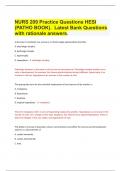
NURS 209 Practice Questions HESI (PATHO BOOK). Latest Bank Questions with rationale answers.
A decrease in workload, use, pressure, or blood supply appropriately describes: A. physiologic atrophy. B. pathologic atrophy. C. hypertrophy. D. hyperplasia. - B. pathologic atrophy. Pathologic atrophy is a decrease in cell size due to decreased use. Physiologic atrophy usually occurs early in development; for example, the thymus gland atrophies during childhood. Hypertrophy is an increase in cell size. Hyperplasia is an increase in the number of cells. The appropriate term for the reve...
- Exam (elaborations)
- • 88 pages •
A decrease in workload, use, pressure, or blood supply appropriately describes: A. physiologic atrophy. B. pathologic atrophy. C. hypertrophy. D. hyperplasia. - B. pathologic atrophy. Pathologic atrophy is a decrease in cell size due to decreased use. Physiologic atrophy usually occurs early in development; for example, the thymus gland atrophies during childhood. Hypertrophy is an increase in cell size. Hyperplasia is an increase in the number of cells. The appropriate term for the reve...

2023 AQA A-level ACCOUNTING 7127/1 Paper 1 Financial Accounting Question Paper & Mark scheme (Merged) June 2023 [VERIFIED]
2023 AQA A-level ACCOUNTING 7127/1 Paper 1 Financial Accounting Question Paper & Mark scheme (Merged) June 2023 [VERIFIED]